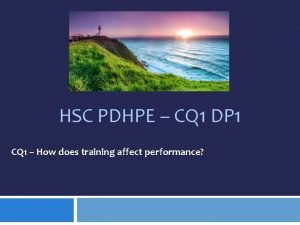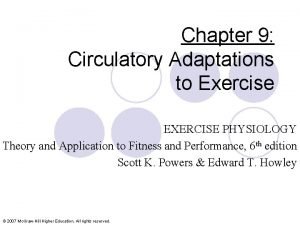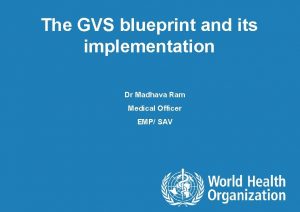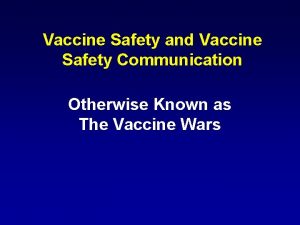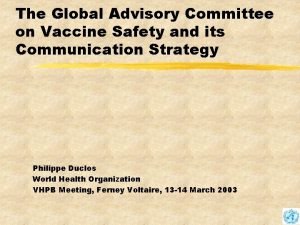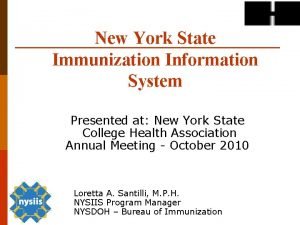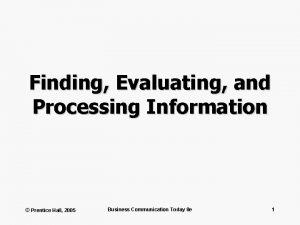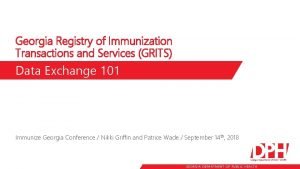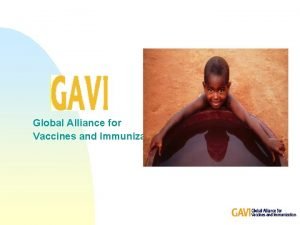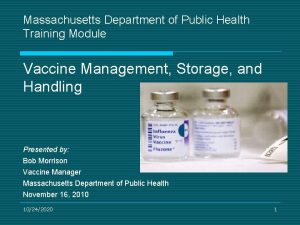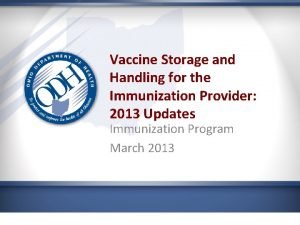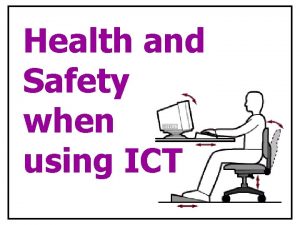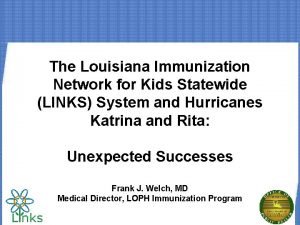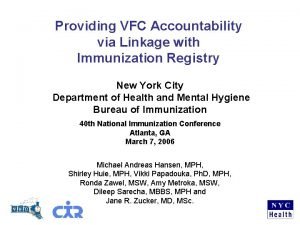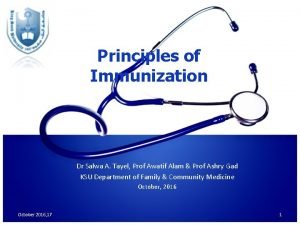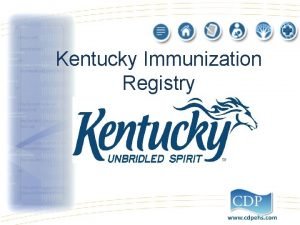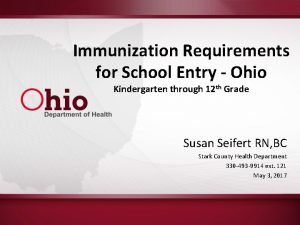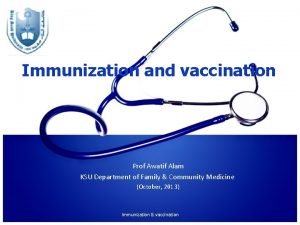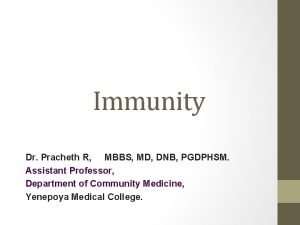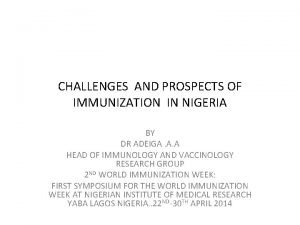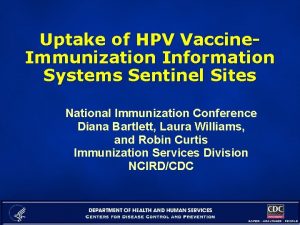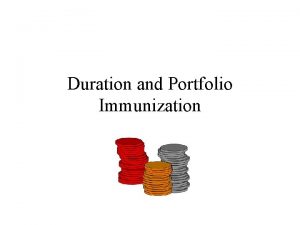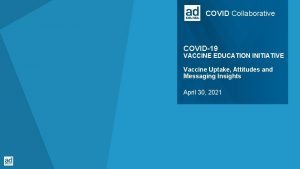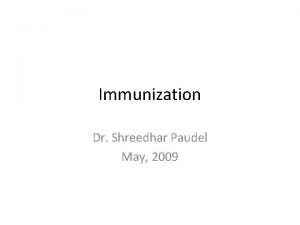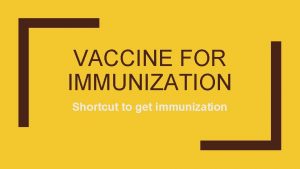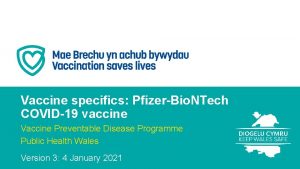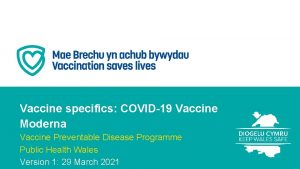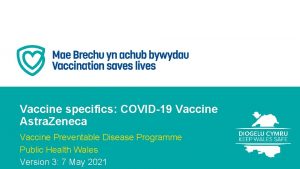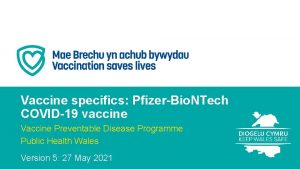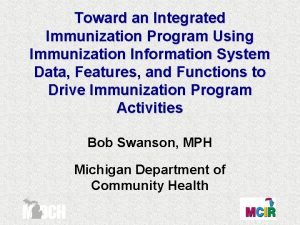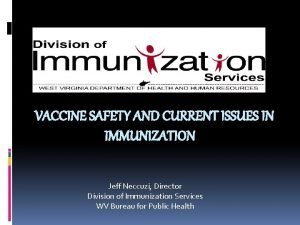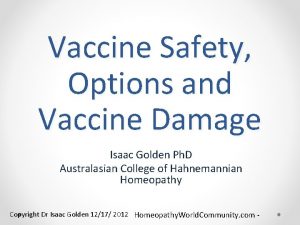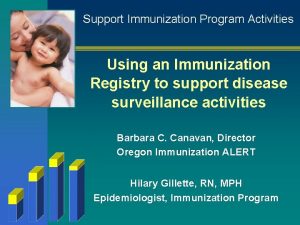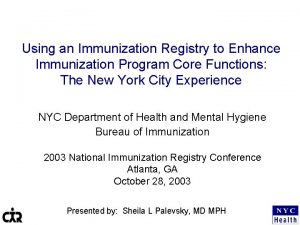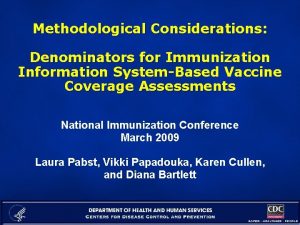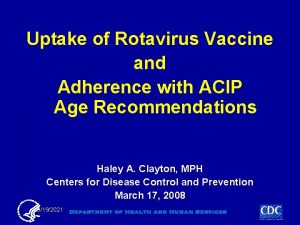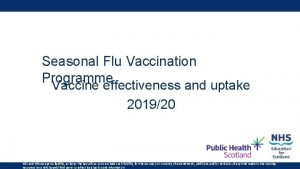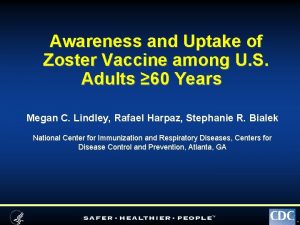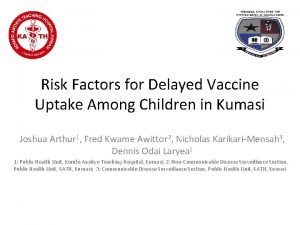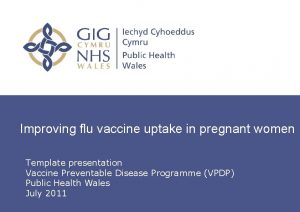Evaluating Vaccine Uptake and Safety Using Immunization Information
























- Slides: 24

Evaluating Vaccine Uptake and Safety Using Immunization Information Systems and VAERS CDC STD Prevention Conference Diana Bartlett, Laura Williams, and Robin Curtis Immunization Services Division NCIRD/CDC The findings and conclusions in this presentation have not been formally disseminated by CDC and should not be construed to represent any agency determination or policy.

Outline § Overview of immunization information § § § systems (IIS) IIS Sentinel Site project – Description – Preliminary data Other assessment methods: – National Immunization Survey (NIS)-Teen – NIS-Adult Safety monitoring: Vaccine Safety Datalink and Vaccine Adverse Event System (VAERS)

Immunization Information Systems (IIS) Confidential, population-based, computerized information systems that were originally designed to collect vaccination data about all children within a geographic area, and now also: – May consolidate vaccination records from multiple providers – Generate reminder and recall vaccination notices – Provide official vaccination forms and facilitate vaccination coverage assessments – Have the goal of interoperability with other health information systems including Electronic Medical Records (EMR)

Age groups participating in an IIS Source: 2006 Immunization Information System Annual Report

Immunization Information Systems Where do the data come from? Electronic Birth Data Since IISs are population-based, birth data for all newborns are imported into the IIS from Vital Records (these data also frequently include first doses of Hepatitis B vaccine). Clinical Data IIS immunization encounter data also come from providers by fax, paperbased documents, and from electronic clinical information systems – including EMRs. Billing Data Some IIS immunization encounter data come from electronic clinical billing systems. Other sources: schools, other public health systems (e. g. , metabolic & lead screening)

IIS in the U. S. • CDC provides annual funding to 56 Immunization Program Grantees (50 states, Washington DC, and 5 large cities) • IIS development and implementation are a required activity component for immunization programs • IIS core data set fields include name, date of birth, race/ethnicity, gender, vaccine information, provider who administered the dose, and eligibility for VFC • 8 grantees receive supplemental funds to serve as Sentinel Sites for IIS-based evaluation projects

Using IIS for Vaccine Coverage Assessments: Strengths & Limitations § Strengths – Can provide valid, timely and detailed geographic coverage estimates – May include information from multiple providers § Limitations – Provider participation may not be sufficiently high in areas of interest and may not fully reflect all types of providers administering vaccines – Estimates may be affected by enrollees’ mobility within state & in/out state – Data may not be adequately de-duplicated (e. g. , multiple records may exist for one child) – Systems may not yet completely represent all age groups of interest

IIS Sentinel Sites Project, 2004 -2007 § Assesses coverage for persons aged <19 years § Requires and employs enhanced data quality procedures § Includes IIS subsets in AZ, MI, MN, MT, OR , and DC: – Representing contiguous geographic counties, postal code areas, or census tracts – Having high (~90%) healthcare provider site participation and enrollment of children in each IIS

Sentinel Site Profiles, 2004 -2007 Site Geographic Area Percentage (%) of Area Providers Participating AZ 7 counties 97% Number of Adolescents Aged 11 -18 Years Enrolled in the Site Registry* 113, 052 DC MI Eastern DC 80/83 counties in state 13 counties in southwest MN Yellowstone area; 12 counties Washington County 95% 91. 6% MN MT OR Adolescents Estimated (%) in Duplicates Registry among with Enrolled ≥ 2 Vaccine (%) Doses 96 0 -1 44, 917 913, 647 83 100 <1 5 96% 16, 379 90 <1 89% 50, 814 99 Unknown 96% 46, 191 100 <1 *Adolescent participation numbers from Quarter 4 2007, provider numbers from 2004 IIS sentinel site funding application

Percentage of enrolled females aged 1118 years with ≥ 1 dose of HPV, by site N=52, 676 N=21, 504 N=444, 047 N=7528 N=25, 539 N=22, 675 Sentinel sites Note: Denominators (N) shown for each site are for females aged 11 -18 years, Quarter 4 2007. Findings are preliminary.

Mean percentage* of enrolled females with ≥ 1 dose of HPV, by age and quarter N=451, 867 N=455, 776 N=564, 057 N=561, 465 N=569, 549 N=573, 969 Quarter and year *Note: Calculations are based on unweighted averages from all 6 sentinel sites. Denominators (N) shown include females aged 11 -18 years at all sites. Findings are preliminary.

Age distribution among female HPV vaccine recipients by age group and site, Qtr 4 2007 N=8372 N=1815 N=53, 391 N=682 N=1653 N=4836 Sentinel site ** Note: Denominators (N) shown are for female vaccine recipients aged 1 1 -18 years, Quarter 4 2007. Findings are preliminary.

Dose distribution* among all HPV vaccine recipients by age group, Quarter 4 2007 N=13, 800 N=28, 971 N=29, 110 Age group * Unweighted average from all 6 sentinel sites. Findings are preliminary.

National Immunization Surveys § Established survey among children aged 19 -35 months currently focuses on 50 states and six urban areas directly receiving federal immunization grant funds – State immunization grantees can choose city/county areas to include in the NIS using their grant funds § NIS-Teen administered in 4 th quarters 2006 and 2007 among persons aged 13 -17 years (national data only) § NIS-Adult administered May-August 2007 for persons aged ≥ 18 years (national data, not record validated)

Next Steps § IIS Sentinel Site project will continue to monitor HPV vaccine uptake § CDC has added vaccine receipt questions to the NHIS, BRFSS, NSCH, and other surveys § The NIS-Teen has been expanded to state/grantee level in 2008 and will continue annually

VAERS § National post-licensure safety surveillance system jointly operated by CDC and FDA § Spontaneous reporting system in existence since 1990; reports submitted by clinicians, manufacturers, patients/parents, others § Subject to well described limitations of passive surveillance including underreporting, stimulated reporting due to media attention and other factors, and lack of availability of denominator data


Acknowledgments § Sentinel Site Colleagues: – Arizona: Lisa Rasmussen and Kathy Fredrickson – Washington, DC: Rosie Mc. Laren and Cherie Thomas – Michigan: Kyle Enger and Laura Rappleye – Minnesota: Karen White and Emily Peterson-Stauffer – Montana: Bekki Kirsch and Joyce Burgett – Oregon: Jim Gaudino and Heather Crawford § National Center for HIV, STD, and Tuberculosis Prevention: Lauri Markowitz § National Center for Immunization and Respiratory Diseases: Sharad Aggarwal, Laura Williams, Angela Calugar, Robin Curtis, Gary Urquhart

For More Information § Contact: – Diana Bartlett: dbartlett@cdc. gov Thank you!

Extra slides (as needed)

Dose distribution* among all 11 -12 year old HPV vaccine recipients by quarter N=14 N=371 N=1798 N=4282 Quarter & year ** Denominators listed for all sites, 11 -12 year olds N=8615 N=13, 800

Dose distribution* among all 13 -15 year old HPV vaccine recipients by quarter N=31 N=674 N=3720 N=9295 Quarter & year ** Denominators listed for all sites, 13 -15 year olds N=18, 336 N=28, 971

Dose distribution* among all 16 -18 year old HPV vaccine recipients by quarter N=39 N=626 N=3892 N=10, 219 N=19, 400 N=29, 110 Quarter & year ** Denominators listed for all sites, 16 -18 year olds

VAERS and HPV vaccine § As reported during the June 2007 ACIP meeting: – 1763 total reports as of May 8, 2007 – 87% occur with HPV 4 alone and 3% with concurrent administration of MCV 4 vaccine – 73% of reports came from the vaccine manufacturer and 15% from provider – 94 serious reports (5% of total reports)
 Stroke volume pdhpe
Stroke volume pdhpe Chylomicron
Chylomicron At the same oxygen uptake, arm work results in _____.
At the same oxygen uptake, arm work results in _____. Makrositer anemiler
Makrositer anemiler Global vaccine safety initiative gvsi
Global vaccine safety initiative gvsi Vaccine safety communication
Vaccine safety communication Global vaccine safety network
Global vaccine safety network Using and evaluating instructional materials
Using and evaluating instructional materials What is nysiis
What is nysiis Finding evaluating and processing information
Finding evaluating and processing information Finding evaluating and processing information
Finding evaluating and processing information Evaluating composite functions using tables
Evaluating composite functions using tables Grits immunizations login
Grits immunizations login Global alliance for vaccines and immunization
Global alliance for vaccines and immunization Vaccine storage and handling sop worksheet
Vaccine storage and handling sop worksheet Vaccine storage and handling protocol
Vaccine storage and handling protocol Ict health and safety
Ict health and safety Louisiana immunization links
Louisiana immunization links Cir immunization registry
Cir immunization registry Importance of immunization slideshare
Importance of immunization slideshare Immunization registry kentucky
Immunization registry kentucky Ohio immunization summary for school attendance
Ohio immunization summary for school attendance 3alam 3awatif
3alam 3awatif Vitamin a dose in immunization schedule
Vitamin a dose in immunization schedule Challenges of immunization in nigeria
Challenges of immunization in nigeria
